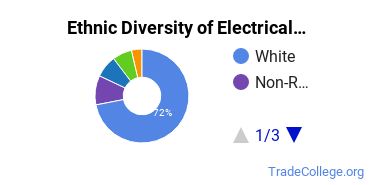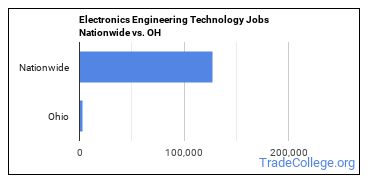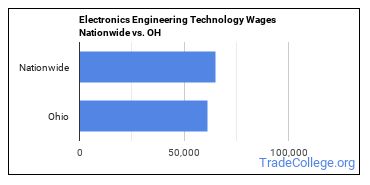Electronics Engineering Technology Schools in Ohio
In 2021-2022, 275 students earned their Electrical Technology degrees in OH.
In this state, Electronics Engineering Technology is the 23rd most popular major out of a total 190 majors commonly available.
Featured schools near , edit
Education Levels of Electronics Engineering Technology Majors in Ohio
Electrical Technology majors in the state tend to have the following degree levels:
| Education Level | Number of Grads |
|---|---|
| Associate Degree | 173 |
| Award Taking Less Than 1 Year | 48 |
| Bachelor’s Degree | 32 |
| Award Taking 1 to 2 Years | 22 |
| Award Taking 2 to 4 Years | 22 |
Gender Distribution
In Ohio, a electrical technology major is more popular with men than with women.

Racial Distribution
The racial distribution of electrical technology majors in Ohio is as follows:
- Asian: 2.9%
- Black or African American: 5.5%
- Hispanic or Latino: 4.0%
- White: 77.5%
- Non-Resident Alien: 4.7%
- Other Races: 5.5%

Jobs for Electronics Engineering Technology Grads in Ohio
In this state, there are 2,900 people employed in jobs related to an electrical technology degree, compared to 126,950 nationwide.

Wages for Electronics Engineering Technology Jobs in Ohio
Electrical Technology grads earn an average of $61,040 in the state and $65,050 nationwide.

Most Popular Electronics Engineering Technology Programs in OH
There are 11 colleges in Ohio that offer electrical technology degrees. Learn about the most popular 11 below:
The full-time teacher rate is 100%. Grads earn an average early-career salary of $33,311 after earning their degree at this institution. 96% of students get financical aid.
82% of students are awarded financial aid at this school. Grads earn an average early-career salary of $32,538 after earning their degree at this institution. A typical student attending Columbus State will pay a net price of $7,254.
The 2.90% student loan default rate is lower than average. The student to faculty ratio is 14 to 1. A typical student attending Owens State Community College will pay a net price of $9,702.
A typical student attending Stark State College will pay a net price of $6,869. Of all the teachers who work at the school, 30% are considered full time. 82% of students are awarded financial aid at this school.
The student to faculty ratio is 17 to 1. The average student takes 4.61 years to complete their degree at University of Akron Main Campus. Graduates earn an average $37,152 after graduation.
The student loan default rate of 0.90% is a good sign that graduates can afford their loan payments. 32% of the teachers are full time. 80% of students are awarded financial aid at this school.
69% of students are awarded financial aid at this school. Grads earn an average early-career salary of $35,097 after earning their degree at this institution. 35% of the teachers are full time.
The student to faculty ratio is 15 to 1. 73% of students are awarded financial aid at this school. The 4.30% student loan default rate is lower than average.
Most students complete their degree in 4.52 years. 49% of the teachers are full time. A typical student attending Cleveland State University will pay a net price of $15,544.
The full-time teacher rate is 100%. The student to faculty ratio is 14 to 1. The 1.50% student loan default rate is lower than average.
The 3.60% student loan default rate is lower than average. Seeking financial aid? At this school, 93% of students receive it. In their early career, Hocking Technical College grads earn an average salary of $30,291.
Electronics Engineering Technology Careers in OH
Some of the careers electrical technology majors go into include:
| Job Title | OH Job Growth | OH Median Salary |
|---|
Related Majors in Ohio
Below are some popular majors in the state that are similar to electrical technology.
| Major | Annual Graduates in OH |
|---|---|
| Other Electrical Engineering | 442 |
| Laser & Optical Technology | 1 |
| Telecommunications Technology | 1 |
View all majors related to Electronics Engineering Technology
Explore Major by State
Alabama
Arkansas
Connecticut
Florida
Idaho
Iowa
Louisiana
Massachusetts
Mississippi
Nebraska
New Jersey
North Carolina
Oklahoma
Rhode Island
Tennessee
Vermont
West Virginia
View Nationwide Electronics Engineering Technology Report
References
More about our data sources and methodologies.
Featured Schools
 Request Info
Request Info
|
Southern New Hampshire University You have goals. Southern New Hampshire University can help you get there. Whether you need a bachelor's degree to get into a career or want a master's degree to move up in your current career, SNHU has an online program for you. Find your degree from over 200 online programs. Learn More > |

